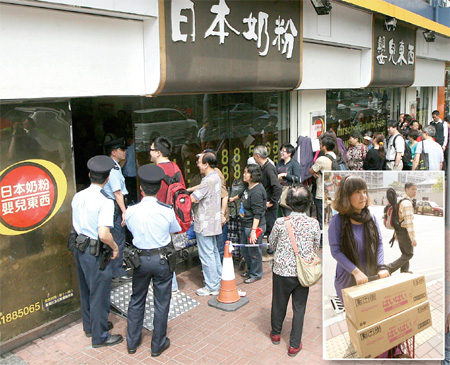Nuclear incident triggers local hoarding
Updated: 2011-03-15 07:05
By Timothy Chui(HK Edition)
|
|||||||
|
More than a hundred people queue up for not-yet-contaminated Japanese milk powder outside an infant product store at Prince Edward on Monday. Insert: A woman carts away two boxes of milk powder that she just bought at the shop. Provided to China Daily |
Hong Kong stood at full alert as radioactive disaster loomed in earthquake-and-tsunami-stricken Japan.
Japanese authorities continued to scramble Monday to arrest core meltdown, the potential hazard of an out-of-control nuclear reaction at a Fukushima nuclear complex.
In Hong Kong, fears of irradiated food led to hundreds of anxious caregivers buying up entire stocks of uncontaminated Japanese milk powder at a Prince Edward store.
Police stood by, maintaining crowd control, as about 300 people stood in line for four hours to buy milk powder.
Speaking to reporters Monday, Secretary for Food and Health York Chow said the government had a "contingency plan" for any nuclear crisis that will affect Hong Kong. So far the Hong Kong Observatory has not detected any radiation increase in Hong Kong."
Westerly winds over the next few days are expected to blow any radioactive material away, the observatory said.
Chow also urged those coming in from Japan to have their radiation levels checked at hospitals, adding imports of foodstuffs will not be suspended but will continue to be screened. He said foods shipped by sea was likely unaffected but airborne imports will receive greater scrutiny.
He said the most at-risk items were dairy products, fresh fruits and vegetables.
Professor Way Kuo, a nuclear engineer of the City University of Hong Kong, said radiation leaks from a second explosion Monday had not ruptured the reactor core housing and was unlikely to affect Hong Kong because of mild weather, but he added precipitation will raise risks at ground level.
He added the city's closest reactor, at Daya Bay, has a more advanced design and had multiple fail-safes compared to the older Fukushima reactor.
The government has issued a black travel advisory for hard-hit Fukushima Prefecture, where food and fuel supplies are virtually gone while the rest of the nation is under a red travel advisory.
Cathay Pacific has offered special one-way fares for locals to return, valid up until the March 23. The Immigration Department has received 4,131 enquires with 25 out of 416 families still unable to reach members in Japan.
Meanwhile, Wing On Travel has canceled 31 tours to Japan, including trips to Tokyo, Osaka, along with destinations in Hokkaido and Okinawa Islands. Some 45 groups made up of roughly 900 tourists have been affected. Japan Tours has also canceled tours to Tokyo, affecting 100 customers.
Airport connections between Japan and Hong Kong have been restored, an Airport Authority spokeswoman said.
Internet connections to the United States sites have been restored, according to a spokeswoman for the Office for the Telecommunications Authority, who said network providers have rerouted traffic away from damaged cables off the coast of Japan, which slowed connections over the weekend.
The area around the stricken Japanese reactor was rocked by magnitude 6.1 scale aftershocks and there was a second hydrogen explosion at one of its nuclear complexes over the weekend.
A cataclysmic flood triggered by Japan's biggest recorded earthquake inundated swaths of the nation's main island Friday after an 9.0 magnitude trembler wiped out entire villages.
The receding tide left a formidable humanitarian disaster in what was described by Prime Minister Naoto Kan as the worst calamity the country had faced since World War II.
The tremor which had severed infrastructure and power also led to the failure of cooling equipment at nuclear reactors in the Fukushima nuclear complex where authorities are using seawater mixed with boron as a last-ditch attempt to prevent further explosions or a meltdown.
China Daily
(HK Edition 03/15/2011 page1)
